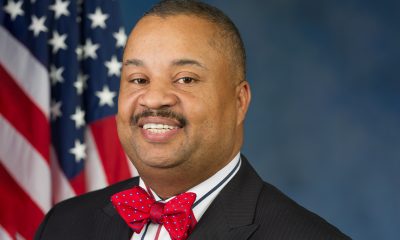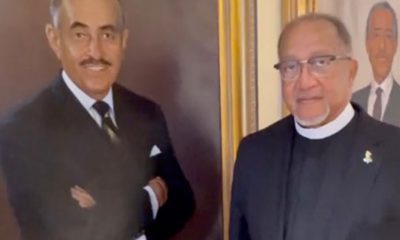National
Fraternity in Racist Video Has Roots in Antebellum South


A sign post is seen outside the international headquarters of Sigma Alpha Epsilon in Evanston, Illinois on March 10, 2015. Sigma Alpha Epsilon’s international headquarters may be in Illinois, but the fraternity’s roots are firmly planted in the antebellum South. (AP Photo/Teresa Crawford)
ALLEN G. BREED, AP National Writer
Sigma Alpha Epsilon was born a few years before the Civil War in the antebellum South, the creation of a small group that set out to forge bonds among young men that would “hold them together for all time.”
The fraternity founded at the University of Alabama held its Southern heritage close. “We came up from Dixie land,” says a ditty from an old SAE songbook.
But nearly 160 years later, another song — this one chanted by members of the frat’s University of Oklahoma chapter and containing racial slurs and lynching references — hearkens back to the land of cotton and puts a new spotlight on the group’s history.
SAE officials insist the chant that resulted in suspension of the chapter is neither a sanctioned song nor is it taught to fraternity members.
If there are any other chapters that use the song, “we need to address that with those chapters and stop it immediately to stamp out this type of behavior,” SAE spokesman Brandon Weghorst said.
The lyrics “are so hateful and spiteful that it’s embarrassing to think that Sigma Alpha Epsilon members would even know the chant or how it goes, if they’ve heard it.”
The fraternity was also investigating reports of other SAE incidents that may have been tainted with racism, Weghorst said.
SAE began on the Tuscaloosa campus on March 9, 1856, a few months after Noble Leslie DeVotie outlined his vision to a close circle of friends during a stroll along the banks of the Black Warrior River.
The founders envisioned the members sharing a lifelong bond, according to a 1916 history of the fraternity by William C. Levere.
“So it came about that in the late hours of a stormy night, the friends met in the old southern mansion and by the flicker of dripping candles organized Sigma Alpha Epsilon,” Levere wrote.
More chapters were soon launched in Tennessee, North Carolina and Washington, D.C., at what is now George Washington University. But the founders were not interested in a national presence.
According to Levere, it was their intention “to confine the fraternity to the southern states.”
When a North Carolina chapter member raised the topic of a “Northern Extension,” charter member Thomas Chappell Cook — who later served as a surgeon in the Confederate army — responded that “the constant agitation of the slavery question was a barrier to northern chapters, as it would preclude the possibility of harmony.”
The Civil War soon put an end to the internal debate.
Because of the fighting, the fraternity’s charter was surrendered in 1861. The Washington City Rho chapter was the only one to emerge from the war intact. SAE would not return to its birthplace until 1886, after the Reconstruction-era ban on “secret societies” was relaxed and the school’s trustees, in Levere’s words, repealed “obnoxious anti-fraternity laws.”
In the meantime, the fraternity had granted its first Northern charter in 1883 to, of all schools, Pennsylvania College — the abolitionist institution now known as Gettysburg College.
The editors of the New Encyclopedia of Southern Culture call SAE “the first Greek-letter society founded in Dixie to take permanent root.”
In December 1930, the fraternity dedicated its international headquarters in the Chicago suburb of Evanston. But, like other fraternities North and South, SAE had not yet embraced racial diversity.
In his 2013 book, “The People’s Advocate,” attorney Daniel P. Sheehan claims credit for championing the bid of Tommy Williamson, who he wrote was the first black man to receive a nomination for membership in SAE.
Sheehan, who said he was social chairman of SAE’s Harvard chapter in 1966, said Williamson’s was the first name he called when it was time to vote for new members.
He and Williamson, a defensive lineman on the Crimson football team, both lived at Kirkland House.
On the first ballot, Sheehan said, Williamson received three “blackballs,” or negative votes.
Sheehan then announced he would blackball every other nominee until whoever had blocked Williamson “fessed up and gave us their reasons,” he wrote. It took six more ballots for a member to admit that he was voting against Williamson because he’d heard that the Piedmont, California, native dated white women.
Sheehan said Williamson’s nomination was approved on the seventh ballot. But when Sheehan told him how the vote had gone down, he wrote, Williamson declined the invitation.
Reached by telephone Tuesday, Williamson, who practices employment law in Washington, D.C., told The Associated Press that he wasn’t really interested in joining a fraternity, especially if some members didn’t want him.
“I didn’t want to be the sort of obsessive token negro,” he said.
Weghorst was unable to say whether Williamson was indeed the first black man formally invited to join a chapter because only within the last couple of years has the organization started to track the ethnicity of people who join, he said.
SAE has had its share of controversy in more recent years.
— In 1988, the founding chapter was suspended for violations of the university’s drug codes. The suspension was lifted two years later, only to be levied again in 1992 when the chapter failed to meet the goals outlined for reinstatement.
Most of the actions taken against SAE in the past have been for infractions of a non-racial nature. But the University of Oklahoma video is not an isolated incident.
— In October 2006, the University of Memphis chapter was investigated after a freshman member complained that his brothers made inappropriate remarks to and about his black girlfriend. Two members were later suspended.
— In February 2013, Washington University in St. Louis suspended its SAE chapter while investigating claims that pledges engaged in racially offensive behavior toward minorities.
— In December 2014, Clemson University suspended the frat after a gang-themed “Cripmas party” at which white members dressed in T-shirts bearing images of handcuffs and the late rapper Tupac Shakur.
Last year, SAE reached what it called “a historic milestone” — becoming the first large national fraternity to eliminate the pledge process.
“Instead, we have implemented a holistic education known as the True Gentleman Experience,” SAE says on its website. “It provides education throughout a member’s collegiate tenure and fosters both personal and professional development.”
___
Associated Press writers Kelly P. Kissel in Little Rock and Teresa Crawford in Chicago also contributed to this story.
___
Allen G. Breed is an AP national writer based in Raleigh, North Carolina. He can be reached at features@ap.org. Follow him on Twitter at https://twitter.com/AllenGBreed.
Copyright 2015 The Associated Press. All rights reserved. This material may not be published, broadcast, rewritten or redistributed.







































